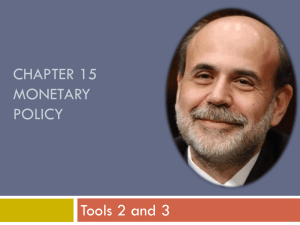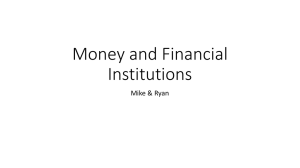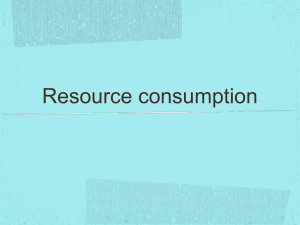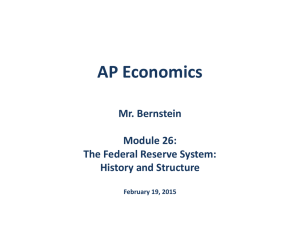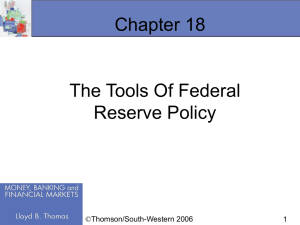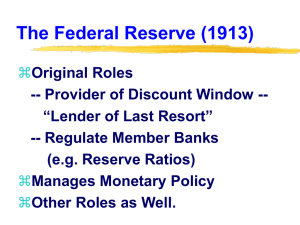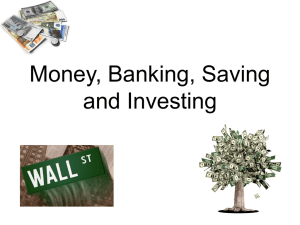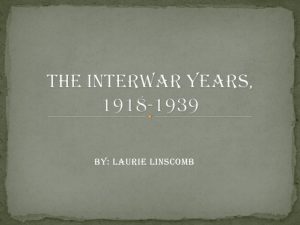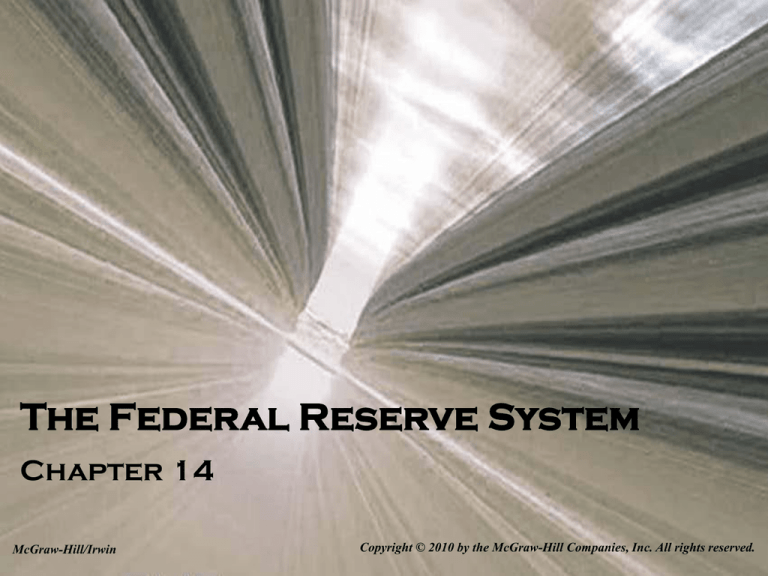
The Federal Reserve System
Chapter 14
McGraw-Hill/Irwin
Copyright © 2010 by the McGraw-Hill Companies, Inc. All rights reserved.
The Federal Reserve System
• This chapter examines the mechanics of
government control
– How does the government control the amount of
money in the economy?
– Which government agency is responsible for
exercising this control?
– How are banks and bond markets affected by the
government’s policies?
14-2
The Federal Reserve System
• The government must regulate bank lending if
it wants to control the amount of money in the
economy
• Monetary policy: The use of money and
credit controls to influence macroeconomic
outcomes
14-3
Structure of the Fed
• The Federal Reserve was created in 1913 to
avert recurrent financial crises
• Each of the twelve (12) Federal Reserve banks
act as central banker for the private banks in
their region
14-4
Federal Reserve Banks
• Each regional Fed bank provides services:
–
–
–
–
Clearing checks between private banks
Holding bank reserves
Providing currency
Providing loans to private banks
14-5
The Board of Governors
• The seven-person Board of Governors sets
monetary policy
• Each governor is appointed to a 14-year term
by the President (with confirmation by the
U.S. Senate)
• The President selects one of the governors to
serve as chairman for a 4-year term
14-6
The Federal Open Market Committee
(FOMC)
• The FOMC is a twelve member group (the
seven governors along with five of the 12
regional Reserve bank presidents)
• The FOMC oversees the daily activity of the
Fed and meets every 4-5 weeks to review
monetary policy and outcomes
14-7
Structure of the Federal Reserve System
Federal Open
Market Committee
(12 members)
Board
of
Governors
Federal Advisory
Council and
other committees
(7 members)
Federal Reserve banks
(12 banks, 25 branches)
Private banks
(depository institutions)
14-8
Monetary Tools
• The Federal Reserve controls the money
supply using three policy instruments:
– Reserve requirements
– Discount rates
– Open-market operations
14-9
Reserve Requirements
• Required reserves – The minimum amount of
reserves a bank is required to hold
• By changing the reserve requirements, the Fed
can directly alter the lending capacity of the
banking system
Required
required
total
reserves
reserve ratio
deposits
14-10
Reserve Requirements
• By changing the reserve requirement, the Fed
changes the level of excess reserves in the
banking system
• Excess reserves: Bank reserves in excess of
required reserves
Excess
total
required
reserves
reserves
reserves
14-11
Reserve Requirements
• The money multiplier determines how much in
additional loans the banking system can make
based on their excess reserves
1
Money multiplier
required reserve ratio
Available lending capacity
money
excess reserves
of the banking system
multiplier
14-12
Reserve Requirements
• By raising the required reserve ratio, the Fed
reduces lending capacity in the banking system
• A change in the reserve requirement causes a
change in:
– Excess reserves
– The money multiplier
– The lending capacity of the banking system
14-13
Impact of an Increased Reserve
Requirement
Required Reserve Ratio
20 percent
25 percent
Total deposits
$100 billion
$100 billion
Total reserves
30 billion
30 billion
Required reserves
20 billion
25 billion
Excess reserves
10 billion
5 billion
5
4
$ 50 billion
$ 20 billion
Money multiplier
Unused lending capacity
14-14
The Discount Rate
• Excess reserves earn no interest, so banks have
a profit incentive to keep their reserves as
close to the required reserve level as possible
• Because banks continually seek to keep excess
reserves at a minimum, they run the risk of
falling below reserve requirements
14-15
Excess Reserves and Borrowings
Excess reserves represent unused lending capacity. Hence, banks strive to keep
excess reserves at a minimum.
14-16
The Federal Funds Market
• A bank that finds itself short of reserves can
turn to other banks for help
• Reserves borrowed from another bank are
called federal funds
• Federal funds rate: The interest rate for
interbank reserve loans
14-17
Sale of Securities
• Banks use some of their excess reserves to
purchase government bonds
• A bank that is low on reserves can also sell
securities
14-18
Discounting
• Discounting: Federal Reserve lending of
reserves to private banks
• Discount rate: The rate of interest the Federal
Reserve charges for lending reserves to private
banks
• Changing the discount rate affects the cost and
incentive for banks to borrow reserves
14-19
Open-Market Operations
• Open-market operations are the Fed’s principal
mechanism for altering the reserves of the
banking system
• The Fed’s open-market operations focus on the
portfolio choices people make
14-20
Hold Money or Bonds?
• Portfolio decision: The choice of how (where)
to hold idle funds
• People do not hold all their idle funds in
transactions accounts or cash
• The Fed attempts to influence the choice by
making bonds more or less attractive
14-21
Open Market Operations
Fed SELLS bonds
Buyers spend
account balances
The Fed
Open
market
operations
The
Public
Banks
Sellers deposit
Fed BUYS bonds
Reserves
decrease
bond proceeds
Reserves
increase
14-22
The Bond Market
• Bond: A certificate acknowledging a debt and
the amount of interest to be paid each year
until repayment; an IOU
• Bonds can be resold to someone else at any
time
14-23
Bond Yields
• Yield: The rate of return on a bond
annual interest payment
Yield
price paid for bond
• A principal objective of Federal Reserve open
market activity is to alter the price of bonds,
and therewith their yields
14-24
Open Market Activity
• Open market operations: Federal Reserve
purchases and sales of government bonds for
the purpose of altering bank reserves
• By buying bonds, the Fed increases bank
reserves
• By selling bonds, the Fed reduces bank
reserves
14-25
An Open-Market Purchase
Regional Federal
Reserve bank
Federal Open
Market Committee
Step 3: Bank deposits
check at Fed bank, as
a reserve credit
Step 1: FOMC purchases
government bonds; pays
for bonds with Federal
Reserve check
Private
bank
Step 2: Bond seller
deposits Fed check
Public
14-26
The Fed Funds Rate
• The federal funds rate is a highly visible signal
of Federal Reserve open market operations
• If the Fed is pumping more reserves into the
banking system, the federal funds rate will
decline
• If the Fed is reducing bank reserves by selling
bonds, the federal funds rate will increase
14-27
The Fed Funds Rate
• The Fed doesn’t actually set the federal funds
rate
• The Fed it sets a target rate and then conducts
open market operations to achieve it
• Other market interest rates tend to move in the
same direction
14-28
Increasing the Money Supply
• To increase the money supply, the Fed can:
– Lower reserve requirements
– Reduce the discount rate
– Buy bonds
14-29
Lowering Reserve Requirements
• Lowering reserve requirements is an expedient
way of increasing the lending capacity of the
banking system
– Excess reserves in the banking system increase
– Banks expand deposits through loans
– The money supply increases
14-30
Lowering the Discount Rate
• Profitability of discounting depends on the
difference between the discount rate and the
interest rate banks charge on loans
• Lowering the discount rate increases this
– Banks become more willing to borrow reserves
– Banks make more loans, increasing the money
supply
14-31
Buying Bonds
•
•
•
•
The Fed purchases bonds from bond sellers
Sellers deposit proceeds of sales in banks
Excess reserves increase
The money supply increases as banks make
additional loans
14-32
Federal Funds Rate
• When the Fed starts bidding up bonds, bond
yields and market interest rates start falling
• The federal funds rate also falls, giving
individual banks incentive to borrow reserves
• This accelerates deposit (loan) creation
14-33
Decreasing the Money Supply
• To reduce the money supply, the Fed can:
– Raise reserve requirements
– Increase the discount rate
– Sell bonds
14-34
Focus on Fed Funds Rate, not
Money Supply
• The Fed has shifted from money-supply targets
to interest rate targets
• The Fed will continue to use the federal funds
rate as its primary barometer of monetary
policy
14-35
The Federal Reserve System
End of Chapter 14
McGraw-Hill/Irwin
Copyright © 2010 by the McGraw-Hill Companies, Inc. All rights reserved.

